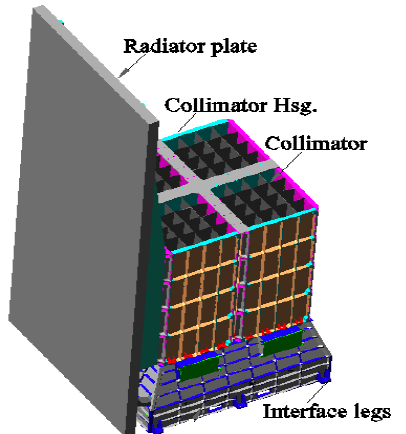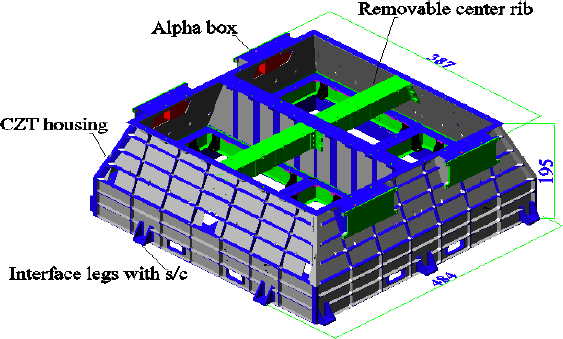ASTROSAT Cadmium Zinc Telluride Imager (CZTI):
ASTROSAT will carry a hard X-ray imager in the form of CZTI. It
will consist of a Pixellated Cadmium-Zinc-Telluride detector array
of ~1000 cm2 geometric area.
These detectors have very good detection efficiency, close to 100%
up to 100 keV, and have a superior energy resolution (~2% at 60 keV)
compared to scintillation and proportional counters. Their small
pixel size also facilitates medium resolution imaging in hard x-rays.
The CZTI will be fitted with a
two dimensional coded mask,
for imaging purposes. The sky brightness distribution will be
obtained by applying a deconvolution procedure to the shadow
pattern of the coded mask recorded by the detector.
The main characteristics of the CZT imager will be as follows:
| Detector |
: |
Cadmium-Zinc-Telluride detector array |
| Energy Range |
: |
10 - 150 keV |
| Pixel size |
: |
2.4 mm x 2.4 mm |
| Number of pixels |
: |
16384 |
| Geometric area |
: |
1024 cm2 |
| Field of View |
: |
6o x 6o (10-100 keV)
(defined by collimator)
17o x 17o (>100 keV)
(defined by Coded Mask Housing)
|
| Angular resolution |
: |
8 arc min (<100 keV) |
| Veto layer |
: |
2cm thick CsI crystal+PMT |
| Overall size |
: |
50cm x 50cm x 70cm (height)
(without radiator plate) |
The CZTI will be fabricated in four identical, independent quadrants
which will be joined together in the final configuration. Each quadrant
will have a 64x64 element coded mask and a detector array of the same
number of pixels. The mask pattern of adjacent quadrants will
be rotated by 90o with respect to each other.

CZTI assembly with the radiator plate. All four quadrants are
seen in the figure, as also are the collimator slats. The
coded mask
(not shown) will be placed above the collimator housing.
The height of the radiator plate is 110 cm. It is thermally
connected to the detector chip by heat pipes in order to achieve
passive cooling to about -20
oC at which the CZT
detector module will be operated.

Detail of the base section of the CZTI assembly on which the
collimator housing sits. Accommodation for the radioactive
calibration sources (alpha boxes) are seen. A gap of 10 cm between
the bottom of the collimator and the detector plane allows the
calibration sources to illuminate the whole detector.
The bottom part of the base section contains the veto layer
and the detector electronics. The dimensions marked are in mm.



















